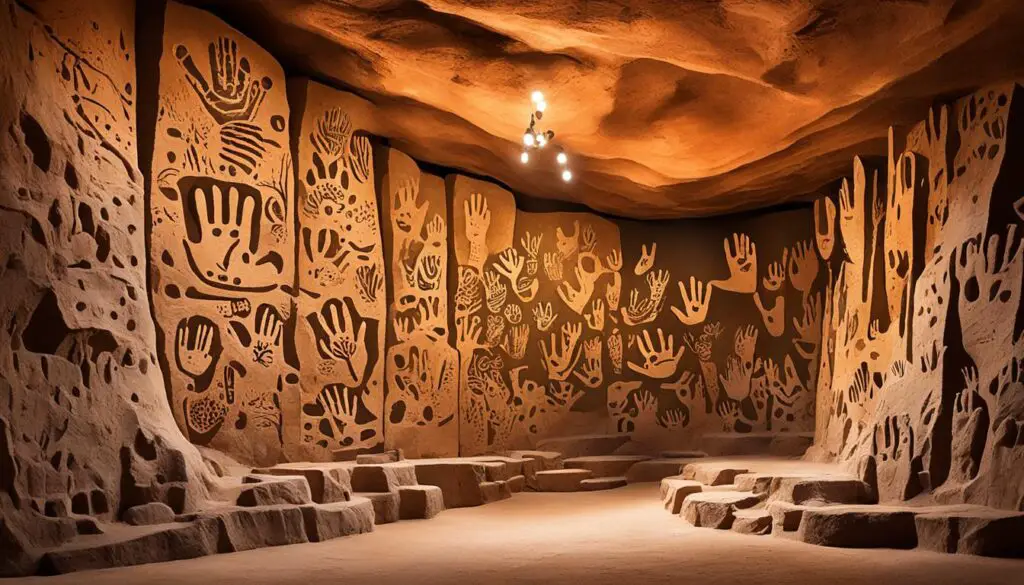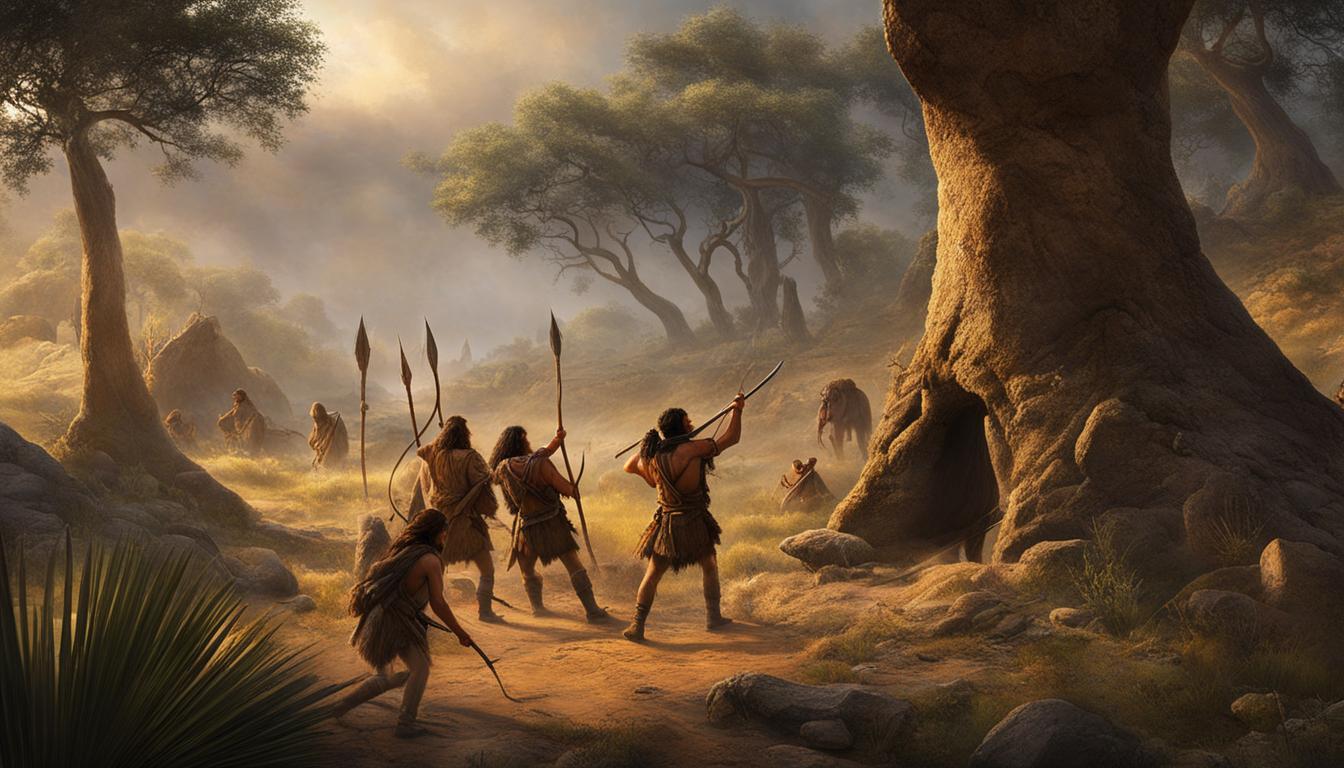The Paleolithic Age, also known as the Old Stone Age, is a fascinating period in ancient history that encompasses over two million years. It is a time when our early ancestors, such as Homo habilis and Homo sapiens, roamed the Earth and laid the foundation for the civilizations we have today. This era, characterized by the Stone Age, brings us closer to understanding our origins and the struggles and triumphs of the human race.
During the Paleolithic Age, our ancestors lived as hunter-gatherers, relying on their instincts, resourcefulness, and deep connection with nature for survival. They navigated an ever-changing world, adapting to different environments, and leaving behind a rich legacy of knowledge and resilience.
Through the exploration of this era, we gain valuable insights into the origins of our present-day societies, the artistry and symbolism of our early kin, and the intricate web of human evolution. Join us on a journey as we unveil the mysteries of the Paleolithic Age and unlock the secrets that shaped our ancient history.
Key Takeaways:
- The Paleolithic Age, also known as the Old Stone Age, spans over two million years and played a crucial role in shaping human history.
- Our early ancestors were hunter-gatherers who relied on their instincts and ancient wisdom to survive in ever-changing environments.
- Paleolithic art, found in ancient grottoes, offers profound insights into the cultural and artistic world of our early ancestors.
- The Neanderthals, our ancient relatives, provide valuable insights into human evolution and the events that unfolded during the Paleolithic Age.
- Exploring the Paleolithic Age helps us understand the origins of our present-day societies and the challenges faced by our early ancestors.
Life on the Edge: Hunter-Gatherers and Survival
The Paleolithic Age was a time of great challenges and resilience for our neolithic ancestors. As hunter-gatherers, their survival depended on their ability to adapt to their ever-changing environment and utilize their keen instincts and ancient wisdom to procure food and essential resources from nature.
Living on the edge meant facing the untamed forces of nature, enduring harsh climates, and constantly seeking new sources of sustenance. Hunter-gatherers were experts in navigating the landscapes they inhabited, exploiting available resources through hunting, fishing, and gathering.
Their daily lives were centered around the pursuit of survival. With no settled agriculture or domesticated animals, neolithic humans relied on their intimate knowledge of the natural world to find food and ensure their communities thrived. It was a constant juggling act, honing their skills as opportunistic foragers and adapting their strategies based on the seasons, migration patterns, and the availability of resources.
The Resourcefulness of Hunter-Gatherers
Resourcefulness was key to the survival of hunter-gatherer societies. They developed innovative tools and techniques to procure food, such as spears, bows and arrows, fish traps, and woven nets. These inventions helped them efficiently capture prey and navigate various landscapes.
Moreover, hunter-gatherers were skilled at identifying edible plants, roots, and berries, enriching their diet and ensuring sustenance during times of scarcity. They understood the medicinal properties of certain plants and their potential uses for healing and alleviating ailments.
Thrive in the Paleolithic Age
Despite the challenges they faced, hunter-gatherers demonstrated remarkable resilience. Their ability to adapt to new environments and their deep connection with nature allowed them to thrive in the Paleolithic Age. Their nomadic lifestyle enabled them to continuously explore and exploit new resources, ensuring their survival for generations.

| Challenges Faced by Hunter-Gatherers | Strategies for Survival |
|---|---|
| Harsh climates | Developing proper clothing and shelters to withstand extreme weather conditions |
| Scarcity of resources | Seasonal migration to follow the abundance of food and water sources |
| Predator threats | Subduing predators using tools and fire, and choosing strategic camping locations |
| Competition with other groups | Efficient hunting and gathering techniques to secure resources |
Table: Challenges Faced by Hunter-Gatherers and Their Strategies for Survival
“Hunter-gatherers exemplify the resilience and resourcefulness of our early ancestors, showcasing their ability to navigate the challenges of the Paleolithic Age.”
The Art of the Periods: Unveiling Paleolithic Art
One of the most captivating aspects of the Paleolithic Age is the art produced by our early ancestors. Deep within ancient grottoes, we find striking cave paintings that showcase the artistic abilities and spiritual beliefs of the people from this time. These captivating artworks depict animals, human figures, and mysterious symbols, offering profound insights into the cultural and artistic world of our early kin.

The Beauty of Paleolithic Art
The cave paintings discovered in ancient grottoes across the Paleolithic landscape are a testament to the ingenuity and creativity of our early ancestors. The intricate details revealed in these paintings demonstrate the mastery of techniques and materials even in the most challenging environments.
“The art of the Paleolithic Age not only showcases the technical skills of our ancestors but also provides a glimpse into their cultural and spiritual beliefs.”
The depiction of animals, such as bison, mammoths, and horses, in these cave paintings reflects the everyday life and survival instincts of our early ancestors. These illustrations are not mere representations; they reveal a deep connection between humans and the natural world. The composition and precision with which these animals are depicted suggest a reverence for nature and an understanding of the delicate balance between humans and the environment.
The Symbolic Language of Paleolithic Art
Another fascinating aspect of Paleolithic art is the inclusion of symbolic elements. Abstract symbols and signs are found alongside the animal and human figures, hinting at a complex system of communication and meaning. The symbolism in these paintings is believed to represent spiritual beliefs, rituals, and significant events in the lives of our ancient kin.
The meaning behind these symbols is not fully deciphered, but their presence tells us that our early ancestors sought to convey their thoughts and experiences through a symbolic language. The combination of animals, humans, and symbols in these cave paintings gives us a glimpse into the rich mythology and belief systems that shaped their lives.
The Stories of Our Ancient Origins
Paleolithic art serves as a time capsule, preserving the stories and experiences of our ancient origins. The paintings found in these grottoes provide a unique window into the lives of our early ancestors, allowing us to connect with their hopes, fears, and aspirations.
By studying Paleolithic art, archaeologists and researchers can piece together the puzzle of our ancient history, unraveling the cultural, social, and artistic tapestry of our early kin. These artworks transcend time, bridging the gap between the distant past and the present, reminding us of our shared roots and the enduring human spirit.
Neanderthals: Our Neolithic Relatives
Unraveling the mysteries of human evolution involves exploring our ancient relatives, the Neanderthals, who lived alongside Homo sapiens for a significant period before their eventual divergence. By studying the intricate web of reality woven between these two species, we gain valuable insights into the forces that shaped our present and the remarkable journey of human evolution.
The Neanderthals, also known as Homo neanderthalensis, were our closest ancient relatives. They inhabited regions across Europe and parts of Asia, displaying remarkable adaptability and survival strategies. Their physical features, such as robust body structure and pronounced brow ridges, distinguished them from Homo sapiens, providing fascinating clues about the evolutionary paths taken by our ancient kin.
Exploring the relationship between Neanderthals and Homo sapiens deepens our understanding of the Paleolithic Age, an era defined by its cultural and technological advancements. By examining archaeological evidence and genetic studies, scientists have made remarkable discoveries about the interactions and interbreeding that occurred between these two groups.
As we uncover the story of our ancient relatives, we gain a more comprehensive picture of our own ancestry. The Neanderthals’ genetic contribution to modern humans and their remarkable similarities to Homo sapiens challenge conventional ideas, reshaping our understanding of the human family tree and the complex tapestry of life in the Paleolithic Age.
FAQ
What is the Paleolithic Age?
The Paleolithic Age, also known as the Old Stone Age, spanned over two million years and played a crucial role in shaping the early history of humanity. It was a time when our early ancestors, such as Homo habilis and Homo sapiens, lived as hunter-gatherers in a vastly different world.
How did our early ancestors survive during the Paleolithic Age?
Our early ancestors relied on their instincts and ancient wisdom to survive in ever-changing environments. They were skilled hunter-gatherers who adapted their strategies to hunt for food and gather essential resources from nature.
What is the significance of Paleolithic art?
Paleolithic art, found in ancient grottoes, includes striking cave paintings that showcase the artistic abilities and spiritual beliefs of our early ancestors. These artworks depict animals, human figures, and mysterious symbols, providing profound insights into the cultural and artistic world of the Paleolithic Age.
What can we learn from studying the Neanderthals?
The Neanderthals, who coexisted with Homo sapiens for a significant period, provide valuable insights into human evolution and the intricate web of reality that shaped our present. Understanding the Neanderthals helps us paint a more complete picture of the Paleolithic Age and the events that unfolded during this epoch.
